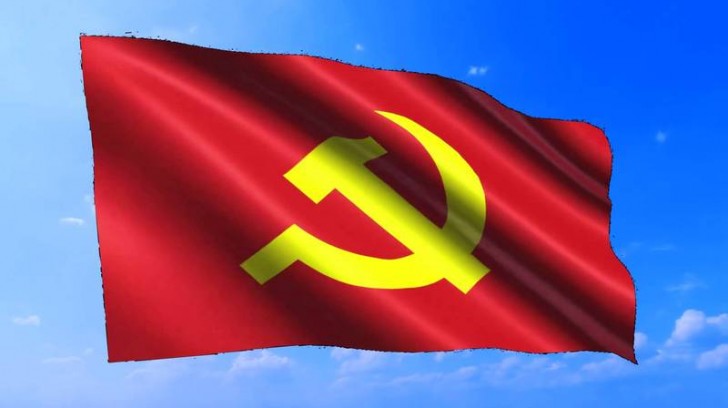
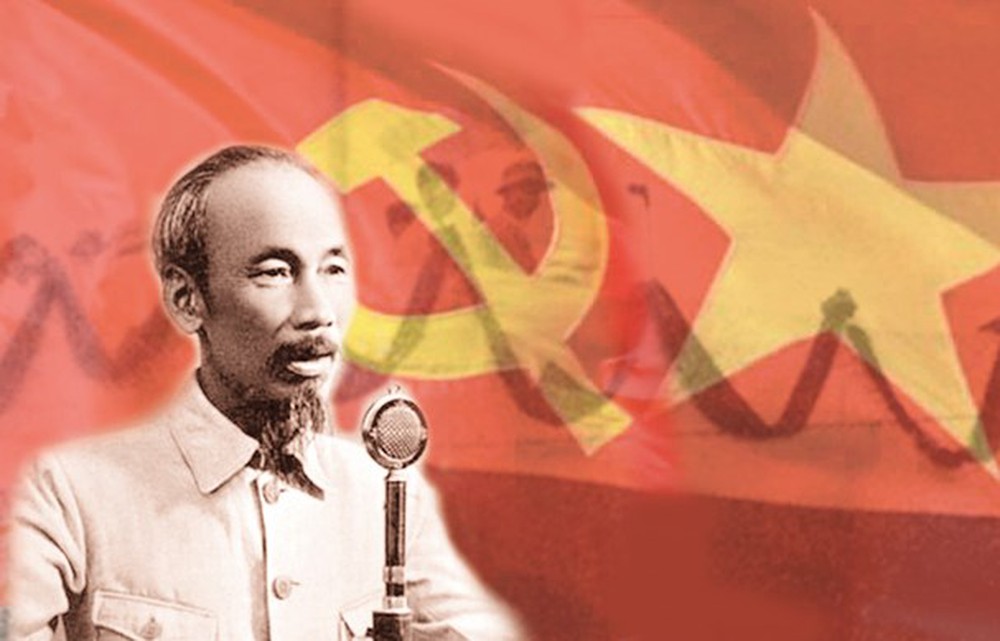
President Ho Chi Minh - the founder and leader of the Communist Party of Vietnam.
1. The Spring of 1930: Founding the Party
While Western capitalist nations rapidly transitioned from a stage of free competition to a stage of monopoly, Vietnam, like most Eastern countries, remained shrouded in the darkness of the medieval era and became targets of conquest.
In the mid-19th century, the dark clouds of colonialism loomed large over Vietnam. The cannonballs fired by the French empire in Da Nang in 1858 heralded a harsh winter. Nearly 30 years later, the Nguyen dynasty, "allowing the French empire to trample on their heads," was forced to sign the Harmand Treaty (1883) and the Patenotre Treaty (1884), bringing to an end the historical mission of the feudal landlord class and leaving "over twenty million compatriots dying in a death trap."[1].
The greater the domination, oppression, and exploitation of the nation, the deeper the national conflict with imperialism became, and the resistance and struggle for national survival intensified, becoming more fierce in nature, diverse in content and form. "When one falls, another rises," patriotic movements against the French took place continuously and heroically, but were all brutally suppressed by the French imperialists.
The failure of the Can Vuong movement in the late 19th century demonstrated the incompetence of feudal ideology in solving the task of achieving national independence. In the early 20th century, embracing bourgeois ideology, many patriots sacrificed themselves to save the country, but they also failed. The country fell into a "dark situation that seemed to have no way out."
In 1917, the Russian October Revolution succeeded "like a thunderclap heralding spring," liberating the colonial peoples within the Russian Empire and opening the eyes of oppressed nations.the era of anti-imperialist revolution, the era of national liberation"[2].
Following the sound of the October Revolution's gunfire, Nguyen Ai Quoc came to "First draft of the theses on the national question and the colonial question.Lenin's words moved him "deeply, enthusiastically, enlightened, and confident," and he affirmed: "This is what we need! This is the path to our liberation!"[3]He creatively applied and developed Marxism-Leninism to the context of colonial Vietnam, building a revolutionary theory of national liberation, then disseminating it in Vietnam, actively preparing ideologically, politically, and organizationally for the birth of a revolutionary political party in Vietnam. Overcoming the enemy's ironclad defenses, Marxism-Leninism and the revolutionary thought of Nguyen Ai Quoc reached the Vietnamese people and were embraced by patriotic Vietnamese as a beacon of truth, "like someone thirsty finding water, or someone hungry finding food," sparking a new revolutionary movement.
By 1929, the anti-French patriotic movement and the Vietnamese workers' movement had developed strongly, demanding unified leadership and a correct political line from a revolutionary party. This objective requirement impacted pre-communist organizations, leading to internal struggles and positive differentiation within these organizations, resulting in the formation of three communist organizations in Vietnam.
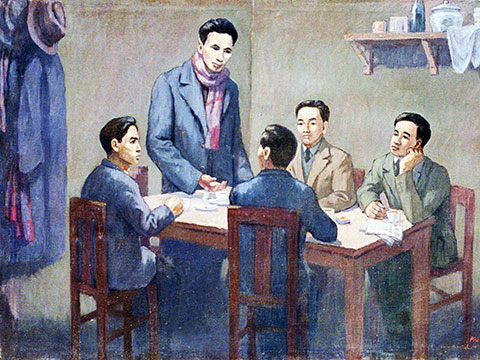
The founding conference of the Communist Party of Vietnam on February 3, 1930. (Photo: a reproduction of a painting by artist Phi Hoanh at the National Historical Museum - Source: dangcongsan.vn)
In early 1930, "as an envoy of the Communist International with full authority to decide on all matters relating to the revolutionary movement in Indochina," Nguyen Ai Quocproactivesummoning "representatives of the two groups (Indochina and Annam)"[4]and chaired the Party Unification Conference in Kowloon (Hong Kong, China).
The birth of the Communist Party of Vietnam was the inevitable result of the national struggle in Vietnam in the new era, a product of the combination of Marxism-Leninism and Ho Chi Minh Thought with the fervent Vietnamese workers' movement and patriotic movement in the 1920s.
Spring 1930 - the spring of the Party's foundingThis marked a great turning point in the development of Vietnam's revolutionary history, ending the crisis of revolutionary leadership that lasted for several decades in the early 20th century, and leading the Vietnamese revolution onto a new path – the path of national independence linked with socialism. "The founding of the Party was an extremely important turning point in the history of our Vietnamese revolution. It proved that our proletariat had matured and was capable of leading the revolution."[5]From this point on, the Vietnamese revolutionary movement truly became an integral part of the world revolution.
From its very inception, "Our Party immediately raised the banner of revolution, uniting and leading our entire people to advance in the struggle for national liberation and class liberation. The Party's bright red flag shone like the rising sun, tearing through the darkness, illuminating the path and guiding our people to steadfastly advance on the path to victory in the anti-imperialist and anti-feudal revolution."[6].
2. In the spring of 1935, the Party was restored.
Having just been established and entrusted with the exclusive mission of leading the Vietnamese revolution, the Party rallied the strength and power of the entire nation, immediately entering a comprehensive test against the imperialist enemy in the revolutionary upsurge from the beginning of 1930, culminating in the Nghe Tinh Soviet, in which the Vietnamese people demonstrated their heroic fighting spirit, self-sacrifice, and creative revolutionary capacity.
The power of the masses and the prestige of the Communist Party grew stronger, making "the imperialists realize that the Communist Party was their most dangerous enemy, that they had to destroy the Communist Party in order to destroy the revolutionary movement." Therefore, from the end of 1930, they concentrated their great forces "to hinder the revolutionary wave and, first and foremost, to decisively eliminate our courageous Communist Party. The number of secret agents in Indochina increased several times; the Foreign Legion was stationed everywhere; tens of thousands of revolutionary fighters were imprisoned and tortured in jails, sentenced to life imprisonment, or beheaded on the guillotine," turning Indochina into "a battlefield full of the blood of workers, peasants, and soldiers."[7].
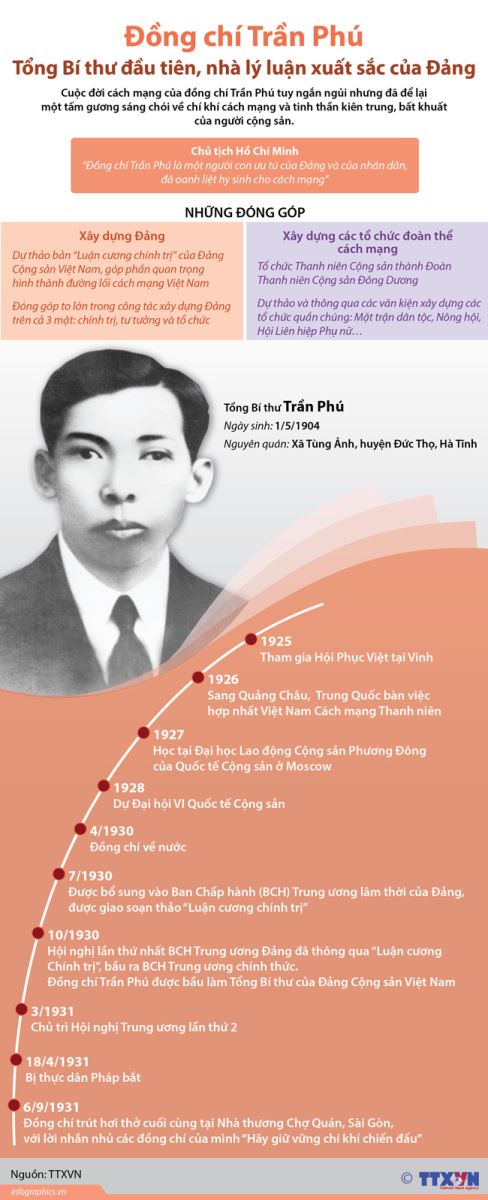
Comrade Tran Phu - the first General Secretary of the Communist Party of Vietnam
From the beginning of 1931, the enemy's terror intensified. The entire Central Executive Committee of the Party was arrested.Not a single Central Committee member remains.[8]The provincial and regional Party committees were all dismantled. In April 1931, in Saigon, General Secretary Tran Phu fell into the hands of the enemy. In June 1931, Nguyen Ai Quoc was illegally arrested and imprisoned by the British authorities in Hong Kong.
The revolution suffered heavy losses and entered years of extremely arduous struggle. This was a severe test for the Communist Party, demanding that the Party possess the courage and fighting spirit to continue to uphold the banner of revolutionary leadership.
In the life-or-death struggle against the enemy, when the revolutionary movement faced difficulties, ideological wavering was inevitable among a few individuals. However, "regardless of social class, the majority of comrades remained extremely loyal, dedicating themselves to the Party to the last drop of blood."[9].
In times of danger, the Party remained steadfast in its revolutionary path and maintained its belief in victory:In the arena of class struggle, temporary victories and defeats are commonplace, and it is through these experiences that the masses learn, for ultimate victory is already assured.”[10].
Through four years of fierce confrontation with the brutal terror of the French colonialists and their collaborators, the Party survived and was quickly restored. The Party's political fortitude, revolutionary heroism, communist qualities and integrity, the fighting spirit of its cadres and members, and the revolutionary spirit of the masses shone brightly in this fierce test.
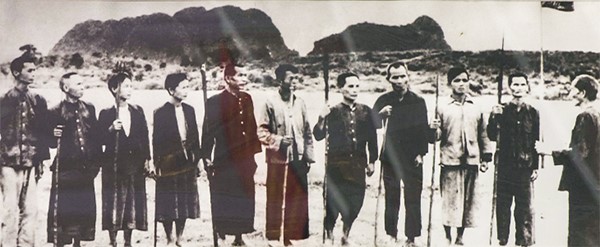
Red Self-Defense comrades from the Hoa Quan and Dong So war zones during the Nghe Tinh Soviet Uprising (Photo courtesy of the Vietnam Military History Museum).
In the imperial prison, the struggle continued. "Turning misfortune into fortune, our comrades used their time in prison to hold meetings and study theory. Once again, this proved that the enemy's extremely brutal policy of terror not only failed to hinder the progress of the revolution, but on the contrary, it became a test of fire, forging the revolutionaries to become even stronger. And the result was that the revolution won, and the imperialists lost."[11].
Party members who were not arrested and those released from short-term prisons secretly continued their activities, reconnecting the party and mass bases, gradually leading the masses to fight for their daily rights.
Thanks to the extraordinary efforts of the Party and international assistance, by the end of 1934, the Party's organizational system and the mass revolutionary movement were restored. The enemy's brutal repression could not break the revolutionary stronghold that the Party had built since the spring of 1930. On the contrary, the Party remained steadfast, its party base and mass political base continued to exist, and the connection between the Party and the masses was always maintained. Through the life-and-death struggle with the enemy, the Party accumulated valuable experience. The ranks of cadres, Party members, and revolutionary masses were trained and refined.
In March 1935, the First Congress of the Party was held in Macau (China). The Congress set out the immediate tasks of the struggle, adopted the Party's political resolution, resolutions on mass mobilization, the Party's charter, and the charters of mass organizations.
Spring 1935 marked the resurgence of the Party.With unwavering political resolve and indomitable fighting spirit, the Party not only bravely overcame difficulties and challenges, achieving fundamental victories in the struggle to preserve and restore the Party's organizational system from the grassroots to the central level, but also prepared for a new struggle, leading the entire nation to continue advancing in the fight against fascism through the democratic movement of 1936-1939 and the direct national salvation movement of 1939-1945, winning the August Revolution of 1945 and establishing the Democratic Republic of Vietnam.
3. In the spring of 1951, the Party began operating openly.
The newly independent nation faced countless difficulties and challenges, surrounded and fiercely opposed by imperialist and reactionary forces. The fate of the nation hung by a thread. The homeland was in peril.
In the winter of 1945, to deflect the enemy's offensive, the Party went underground with a declaration of "self-dissolution" (November 11, 1945). The Party calmly analyzed the situation, determined its policies and solutions; persistently led the struggle to defend the democratic republic, simultaneously waging war and building the nation, overcoming perilous challenges, consolidating and developing the achievements of the August Revolution, preparing its strength and proactively leading the entire nation into a protracted resistance war against French colonial aggression with the spirit of "rather sacrifice everything than lose the country, rather die than be enslaved."[12].
In the winter of 1946, the nationwide resistance war erupted with the initial victory in the fighting in the cities. With the balance of economic and military forces not favorable to the Vietnamese people, and in the context of international encirclement, the Party led our army and people in bravely launching a comprehensive, protracted, and self-reliant resistance war, with the belief that "the resistance war will certainly be victorious."
In the winter of 1947, our army and people crushed the large-scale offensive of the French enemy against the Viet Bac base area, foiling their "quick strike, quick victory" strategy.
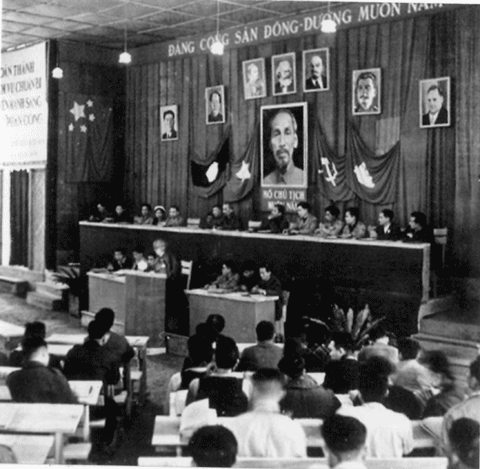
A view of the Second National Congress of Delegates held from February 11-19, 1951, in Vinh Quang commune, Chiem Hoa district, Tuyen Quang province (Photo courtesy of the National Museum of History).
In the winter of 1950, for the first time, our main forces launched a large-scale offensive against the enemy's occupied system, expanding and consolidating the Viet Bac base area, opening up the Vietnam-China border, freeing the resistance war from its encirclement and isolation, and gaining strategic initiative on the main battlefield in Northern Vietnam.
"After four years of nationwide resistance, we have shifted from a passive to an active stance, from a position of weakness to one of strength."[13]The rear base of the resistance was built and consolidated. The people's democratic government grew stronger through the practical management of the resistance and national reconstruction. The people's armed forces, with their three-tiered organizational structure, matured and were rationally deployed on the battlefields, forming the core to elevate people's war to its peak. The great national unity was consolidated and strengthened in the crucible of the all-people resistance.
The international situation from the end of World War II to the early 1950s underwent many changes.The system of socialist countries expanded and connected from West to East. The Soviet Union and the People's Democracies of Eastern Europe overcame many challenges, completed post-war economic recovery (1946-1950), and began implementing long-term socio-economic plans. The Chinese Revolution succeeded (October 1949), positively influencing revolutionary movements in the region. In the offensive trend, national liberation movements in colonial and semi-colonial countries surged strongly everywhere. The movement for peace, democracy, and progress by the working class and working people also developed in capitalist countries. The struggle for world peace became a widespread mass movement.
France suffered increasingly heavy defeats in its Indochina war of aggression, its economy declined, it had to rely on American aid and became dependent on the United States, all of which negatively impacted French sovereignty.
The United States vigorously pursued a global counter-revolutionary strategy, centered on Europe. Through its strategy of "massive retaliation," the US aimed to push back communism. The development and victory of the Chinese revolution led the US to increasingly focus on the Asian region. Following the defeat of the Kuomintang in the Chinese Civil War (1946-1949), the US invaded Korea (1950-1953) and simultaneously intervened more deeply in Indochina, bringing the Indochina War into the strategic orbit of the "Cold War."
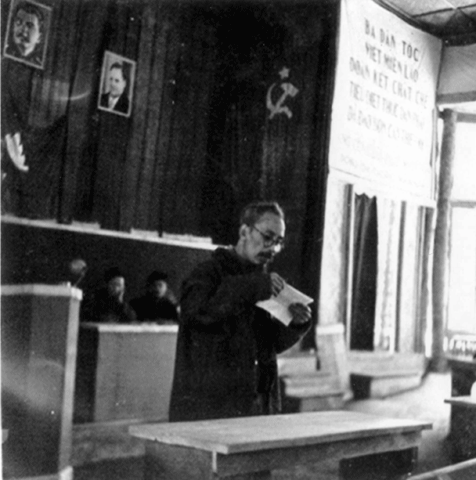
President Ho Chi Minh delivering the political report at the Second National Congress of Delegates, February 1951. (Photo courtesy of the National Museum of History)
The Yalta world order continued to dominate international relations and had a significant influence on the Vietnamese revolution.While China, the Soviet Union, and other people's democracies recognized and established diplomatic relations with the Democratic Republic of Vietnam, assisting the Vietnamese people's resistance, the United States, Great Britain, and several other countries recognized the Bảo Đại regime established by France. The war in Indochina became an international issue between the two sides, which, in the words of French General Yves Gras, "was intertwined with the global conflict between East and West."[14]And according to former US intelligence officer Archimedes LA Patti, "It has been internationalized and become part of America's anti-communist crusade."[15].
Changes in domestic and international situations required the Party to supplement and develop its revolutionary line and foreign policy. In that historical context, President Ho Chi Minh affirmed: “We must have an open party, organized in accordance with the world and domestic situations, to lead the entire people in the struggle until victory.”[16]The Party must expand its ranks to be strong enough to lead the entire people and army in advancing the cause of resistance and national construction, and to sow the seeds for socialism in the future. To fulfill this arduous task, the Party itself must be strong in politics, ideology, and organization. The Party's charter must be revised to suit the new situation. The Party's leadership organs need to be further strengthened.
Vietnam, Laos, and Cambodia united against a common enemy, and in practice formed a fighting alliance between the three nations during the revolutionary and resistance process. Indochina was a battlefield, but each country also had its own unique characteristics. From May 1941, the Eighth Conference of the Central Executive Committee of the Party addressed the national question within each country in Indochina, establishing a united national front in each country. At this point, under the new historical conditions, it was necessary to establish a revolutionary party in each country to formulate a political line appropriate to each country's circumstances.
February 1951,Second National Congress of the PartyIt was convened in Tuyen Quang. This was the first Party Congress held within the country.
Following the initiative of the Vietnamese communists, and with the unanimous support of the Laotian and Cambodian communists, the Congress decided that, due to the needs of the resistance struggle, the working class and people of each country—Vietnam, Laos, and Cambodia—needed their own party. In Vietnam, the Party began operating openly, under the name...Vietnam Labor Party.
According to Ho Chi Minh, "The Vietnam Labor Party unites and leads the entire people in the resistance war until complete victory, regaining complete unity and independence, leading the entire people in implementing new democracy, and building the conditions to advance towards socialism."[17]The Vietnam Labor Party must be “a great, strong, steadfast, clean, and thoroughly revolutionary party"During this period, the interests of the working class, the working people, and the nation are one and the same."Because the Vietnam Labor Party is the party of the working class and the working people, it must therefore be the party of the Vietnamese nation..
Political Platform of the Vietnam Workers' PartyThe Congress adopted the following definition: “The Vietnamese national democratic revolution will inevitably lead Vietnam to socialism... the Vietnamese revolution cannot take any other path than the path to socialism.” “That is a long-term struggle, broadly spanning three stages: the first stage, whose main task is to complete national liberation; the second stage, whose main task is to abolish feudal and semi-feudal remnants, thoroughly implement land reform, develop industry, and perfect the people's democratic system; the third stage, whose main task is to build the foundation for socialism and move towards realizing socialism.”[18].
The Second National Congress of the Party was a momentous event in the political life of the country, marking a significant leap forward in the Party's maturity in all aspects. The Congress summarized an important step in the theory of the Vietnamese revolution, determined the path to conducting the national democratic revolution and advancing towards socialism; and openly declared Vietnam as a vanguard of the socialist bloc in Southeast Asia, a part of the democratic bloc in the world. The correct path set forth by the Congress was a supplement and development of this theory.first political programThe Party's resolution was adopted by the Party's founding conference in the spring of 1930. It was "the congress that pushed the resistance to complete victory and built the Vietnam Labor Party."
In the spring of 1951, the Party began operating openly.From this point on, the Party grew stronger and more mature, becoming seasoned in struggle, leading the entire nation forward, bringing the resistance war to victory, and nation-building to success.
Note:
[1] Ho Chi MinhComplete Collection, Volume 2, National Political Publishing House, Hanoi, 2000, p. 262.
[2]Ho Chi MinhComplete Collection, Volume 8, National Political Publishing House, Hanoi, 2000, p. 563.
[3]Ho Chi MinhComplete Collection, Volume 10, National Political Publishing House, Hanoi, 2000, p. 127.
[4]Communist Party of Vietnam:Complete Collection of Party Documents, Vol. 2, National Political Publishing House, Hanoi, 1998, p. 19.
[5]Ho Chi MinhComplete Collection, volume 10, op. cit., p. 8.
[6]Ho Chi MinhComplete Collection, volume 10, op. cit. p. 3.
[7]Communist Party of Vietnam:Complete Collection of Party Documents, t4, National Political Publishing House, Hanoi, 1999, p. 5.
[8]Communist Party of Vietnam:Complete Collection of Party Documents, t6, National Political Publishing House, Hanoi, 2000, p. 332.
[9]Communist Party of Vietnam:Complete Collection of Party Documents, t6, op. cit., p. 332.
[10]Communist Party of Vietnam:Complete Collection of Party Documents, T4, op. cit., p. 11.
[11]Ho Chi MinhComplete Collection, Volume 10, National Political Publishing House, Hanoi, 2000, p. 4.
[12]Ho Chi Minh City:Complete works,Volume 4, National Political Publishing House, Hanoi, 2000, p. 480.
[13]Ho Chi MinhComplete works,Volume 6, National Political Publishing House, Hanoi, p. 135.
[14]Yves Grass:History of the Indochina War, Plon Publishing House, Paris, 1979, translated version kept at the Military Library, p. 610.
[15]Archimedes LA Patti:Why Vietnam?, Da Nang Publishing House, 2001, p. 770.
[16]Communist Party of Vietnam:Complete Collection of Party Documents, volume 12, op. cit., p. 37.
[17]Communist Party of Vietnam:Complete Collection of Party Documents, volume 12, op. cit., p. 37.
[18]Communist Party of Vietnam:Complete Collection of Party Documents, volume 12, op. cit., pp. 434-435.
Author:Assoc. Prof. Dr. Vu Quang Hien